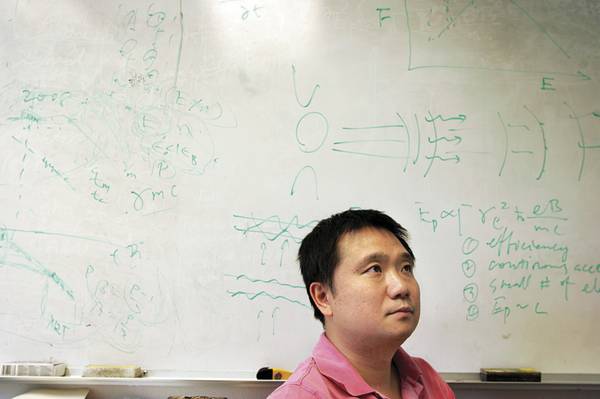Beyond the Sun
Bing Zhang takes the long view, peering back sometimes as far as a billion years after the birth of the universe and some eight billion years before our own sun and planets precipitated from a hydrogen fog drifting in the void.
From this perspective, the 100,000-year history of the human species is a minor rounding error.
Yet Zhang is concerned with events that last a fraction of a second or, at most, almost half an hour. He studies gamma ray bursts — the byproducts of unimaginable violence, worse than an extinction-level asteroid impact or an all-Canadian hockey playoff series, calamities like the collapse of a star into a black hole.
Zhang is an astrophysicist formerly of NASA’s prestigious Goddard Space Flight Center and co-winner of the American Astronomical Society’s 2007 Bruno Rossi Prize in high energy astrophysics. To do his job, he needs — besides a lifetime of training, a keen mathematical mind and the work ethic of an entire ant colony — a computer and a white board.
This is one of two reasons why Zhang is at UNLV. The other?
“I got a job,” Zhang says.
Astrophysics is a competitive field and one cannot remain a postdoc student forever. Eventually, one needs to acquire tenure and postdoc students of one’s own.
Luckily, Zhang is not a particle physicist.
Both astrophysicists and particle physicists are racing to discover the Ultimate Law of Everything, a single theory that can explain the wheeling of galaxies, the quantum dance of quarks and what’s really going on at the heart of a black hole. But particle physicists generally need to attach themselves to particle accelerator labs, which are huge, expensive complexes that hoard their data until publication. Astrophysicists, on the other hand, can work anywhere because they share data from satellites and radio telescopes. So even if an astrophysicist is one of five lead theorists on a NASA satellite mission, as Zhang is, he does not get to keep the data to himself. In fact, at the beginning of the mission, Zhang wore a cell phone and a pager, so that if the satellite detected a gamma ray burst he could immediately process the data, put it online and answer the questions of other astrophysicists.
“Even during the middle of the night,” Zhang says. “Usually, these things happened to me during the middle of the night.”
But perhaps you are wondering exactly what a gamma ray burst is.
When black holes are born or compact stars collide, they shoot off a jet of energy moving at nearly the speed of light. Zhang says the latest data suggest 95 percent of the jet is composed of electromagnetic fields. The remaining 5 percent of the jet is electrons, which pingpong back and forth in the fields, going faster and faster until, in layman’s terms, they go zap.
Gamma ray bursts are so powerful that there is as much energy in one 10-second burst as our sun will produce in its 10 billion-year life. So powerful, in fact, that some have theorized that nearby bursts have caused or could cause massive, planetwide extinctions.
We probably don’t have to worry about any bursts in our neighborhood, Zhang reassures. The Milky Way is all out of the massive stars needed for a gamma ray burst and, anyway, should any large stars form, they will be too metallic to achieve sufficient rotational velocity.
Of course.
Phew.


Join the Discussion:
Check this out for a full explanation of our conversion to the LiveFyre commenting system and instructions on how to sign up for an account.
Full comments policy